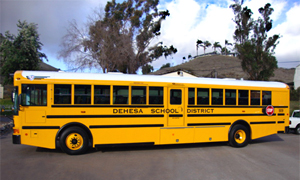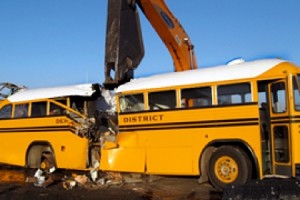Replacing Old School Buses

More than half of today’s school buses have been in service for over a decade. These older buses lack today’s pollution control and safety features, and emit nearly twice as much pollution per mile as a semi-truck. School buses built to meet EPA’s 2010 standards emit 95 percent less pollution than pre-2007 vehicles and are 60 times cleaner than pre-1991 buses!
Older, more polluting school buses can lead to significant health risks for students who typically ride these buses for one-half to two hours a day. Children are more susceptible to air pollution than healthy adults because their respiratory systems are still developing and they have a faster breathing rate. Asthma, which affects 6.3 million American school children, is the most common long-term childhood disease in America, making newer, cleaner buses an urgent priority.

In addition to affecting the health of students, emissions from older buses can have a negative impact on the whole community. Long-term exposure to diesel exhaust damages the lungs and is a likely cause of lung cancer. Particulate matter (PM), which is found in diesel exhaust, is responsible for thousands of premature deaths every year in this country. Diesel pollution also contributes to ozone formation, haze, acid rain, and global climate change.
Older buses are excellent candidates for replacement with newer, cleaner vehicles. Replacing the oldest buses will greatly reduce children’s exposure to diesel exhaust and provide considerable safety improvements.
Reviewing Age and Condition of Bus Fleet
Districts should assess the buses in their fleet for age and condition to determine which buses are ready for replacement. Compiling this information in advance (e.g., bus age, manufacturer, engine model, usage and condition) allows districts to plan for future expenditures and to be prepared when funds become available. Fleet information can be detailed in a Fleet Information Table (1 pg, 50K, June 2012)
Things to Consider When Replacing Buses
Replacing pre-1998 school buses first provides the greatest benefit in terms of diesel emission reductions. The following list provides groupings of engine model years in order of replacement priority.
- Pre 1998
- 1998-2003
- 2004-2006
- Post 2007
Targeting pre-1998 school buses for replacement is not only key to retiring buses that pollute the most, but is also a cost-effective strategy. Older buses often have increased maintenance concerns, decreased fuel economy benefits, and less stringent safety equipment.
Buses Built before 1998
If buses built before 1998 are being used regularly for student transport, they should be ranked as a high priority for replacement. Consider using them on shorter routes to limit student exposure until they can be replaced. If they are used only for special-event trips or are emergency back-up buses, try to limit the amount of time that students spend on them.
Implement an idle reduction policy so that drivers limit the emissions to which students are exposed. It is also important to keep bus engines well maintained and in good working order.
Buses Built between 1998 and 2010
If school buses built between 1998 and 2010 are still in use, there are ways to reduce the emissions they produce.
- Idle Reduction Reducing school bus idling time is a simple, cost-effective way to not only reduce emissions, but also to save money on fuel and prevent engine wear and tear. NCDC has resources available to help you to create and implement an idling reduction policy.
- Retrofit Technologies For older buses that will be kept in the fleet for several years, retrofitting them with emission control and idle reduction technologies can be a cost effective way to reduce emissions.
- Engine Replacements Older diesel engines can be replaced with newer diesel or alternative-fuel engines, such as those using biodiesel or compressed natural gas (CNG). The new engine should be certified to meet the most recent emission standards and come with a diesel particulate filter (DPF) or diesel oxidation catalyst (DOC)
- Fuel Selection By selecting cleaner fuels such as biodiesel or compressed natural gas (CNG), school districts can further reduce emissions from school buses.
When replacing buses between 1998 and 2010, the school district should check with other nearby districts. If the neighboring districts are operating buses that were built prior to 1998 but can’t afford brand new buses, they may be able to use the relatively newer buses as a replacement alternative. Overall, this is a win-win situation for air quality in the whole community.
Bid Specifications
Bid specifications for new bus purchases should require the engine manufacturers provide information about the emission levels of the new, certified bus engines and specify any additional technologies available to further reduce those levels. This could include particulate filters or catalysts verified by EPA or California Air Resources Board (CARB).
Additional bus safety considerations should be included as a part of the specification process. Other factors, such as dealer proximity to the school district, prior successful relationship with dealer or manufacturer, and overall cost, may be considered in comparing the bids.
Finding Finances for Cleaner Buses
Although some communities have schedules for replacing school buses, they may not have the resources to do so as quickly as they would like. Communities want to provide the healthiest conditions possible for transporting their students to school, including reducing their exposure to diesel exhaust from school buses.
By assessing the fleet age and condition, the school district will be more prepared to apply for available funding. Fleet information can be detailed on a Fleet Information Table (1 pg, 50K, June 2012).
Outside funding sources may require or recommend the school district to provide matching funds using financial or other resources. Try to determine the school district’s available resources, whether in-kind (such as staff time) or financial, that could be used as a match for the funds.
- Some districts may work with their community to earmark a portion of their general school capital program for accelerated school bus replacement.
- Some communities or states may make it a priority to support accelerated school bus replacement through public/private partnerships.
- State programs such as California’s Carl Moyer Program or the Texas Emission Reduction Program [TERP] and corporate sponsorships may be available for total or partial replacement costs.
- Some areas have non-profit groups that identify potential funding sources, such as corporate sponsorships, in-kind gifts, or special event fundraising for community-based projects.
- State environmental, health, education or transportation agencies, along with student transportation organizations or local municipal planning organizations, may also be able to provide additional information.
If funding is still limited, the school district may consider an interim measure until funding can be found. By working with a regional school association or neighboring districts, the school district may be able to identify other districts that are replacing their buses. These buses may be relatively newer and purchasing them could result in overall emission reductions for the school district while the district seeks funds for the newest buses.